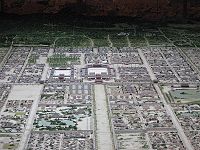Heian period
last major division of classical Japanese history (794 to 1185), named after the capital city of Heian-kyō, or modern Kyōto
The Heian period (平安時代, Heian jidai) is a time in the Japanese history from 794 to 1185. This grouping of years is named after city of Heian-kyō, which is the early name of present day Kyoto.[1]
History
The Heian period began in 794 when the capital of Japan was moved to Heian-kyō. It lasted until 1185, which is the beginning of the Kamakura period.[2]
In this period Kyoto was the center of Japanese culture. It was also in this period that the first known novel was published. The author was a woman. Poetry was very popular in Heian-kyo at the time.
Timeline
- 794: Emperor Kammu moves the capital to Heian-kyō.[3]
- 804: Saichō (also known as Dengyo Daishi) establishes the Tendai Buddhist sect in Japan.[4]
- 806: Kūkai (also known as Kōbō-Daishi) establishes the Shingon Bhuddist sect in Japan[5]
- 858: Reign of Emperor Seiwa begins; the power of the Fujiwara clan expands[6]
- 895: Sugawara Michizane persuades Emperor Uda to suspend Imperial embassies to China.[7]
- 1053: Byōdō-in temple near Kyōto is completed[8]
- 1087: Emperor Shirakawa abdicates and becomes a Buddhist monk, the beginning of the Insei system of Imperial government[9]
- 1185: Death of Emperor Antoku; Taira clan is defeated in the Gempei War[10]
Gallery
- Model of ancient Kyoto with Imperial Palace
- South wing of the Phoenix Hall in the Byodo-In temple in Uji
Related pages
References
Other websites
 Media related to Heian period at Wikimedia Commons
Media related to Heian period at Wikimedia Commons
- Metropolitan Museum of Art, Heian Period (794–1185)
- British Museum, Heian period (AD 794-1185)
- Japan-guide.com, Nara and Heian Periods (710-1185)
🔥 Top keywords: Main PageSpecial:Search0Slash (punctuation)BlackSpecial:RecentChanges4 (number)DavidSOLID (object-oriented design)Wikipedia:AboutFile:Sexual intercourse with internal ejaculation.webmHelp:ContentsHelp:IntroductionLisa Sparxxx2023 UEFA Champions League FinalColour24-hour clockAdolf Hitler UunonaBismillahir Rahmanir Raheem6 (number)T. N. SeshanFile:ASCII-Table-wide.svg20 (number)Poor Things (movie)United StatesCristiano RonaldoList of people who have walked on the MoonAli Malikov50 (number)17 (number)The Valley (2024 TV series)GrassList of mathematical symbolsList of U.S. states and territories by time zone8 (number)List of countries by areaWikipedia:Simple talkList of largest Hindu templesRama


